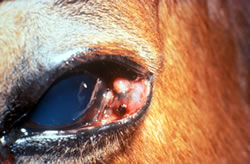Squamous cell carcinoma generally shows up first in the skin, particularly around the eyes, on the penis or vulva, and in other areas where skin meets mucous membranes. It’s especially common in horses with pink skin in these areas, such as Appaloosas, Paints and some draft breeds. Unpigmented skin has poor protection from the sun’s damaging UV rays, which are a factor in causing this cancer.

As it grows, squamous cell carcinoma can begin to invade surrounding tissues, including the eye or even bone. It can also metastasize to other parts of the body. For example, Dr. Eades says, growths around the eyes may spread first to the lymph nodes under the jaw. Once in the lymph system, the cancer can travel to other locations. It’s the most common internal tumor in the intestinal tract, and the second most common overall.
Signs
On the skin, a squamous cell growth may look like a small sore or a red, raised bump. Small growths are often easy to spot when they appear around the eyes, where they’re often on the inner rim of a lid or in the third eyelid (the membrane at the inner corner of the eye). Tumors in other spots, like the sheath, are more easily missed–look for red, raised sores and sometimes a foul odor.
Once the cancer begins to spread, signs vary with the location. Squamous cell carcinoma can locate in the sinuses or upper throat (in the pharynx and larynx) causing noisy breathing. In the esophagus or the stomach, it causes problems in eating.
Treatment
The skin form is treatable. Surgery combined with follow-up treatment is the best option in many cases.
- In surgery, the tumor is cut out along with some surrounding tissue and sent to a lab for analysis. The lab will confirm what it is and determine if the surgery got the entire growth.
- If the tumor can’t be surgically removed (it’s in a difficult place, for example), chemotherapy may be an option. The growths can be injected with a cytotoxic (cell-killing) drug such as cisplatin. Those around the sheath can be treated with a topical drug.
- Squamous cell carcinoma also can be treated with radiation. In one method, radioactive “seeds” are implanted in the tumor and left in place for a few days to destroy the abnormal tissue.
- Cryotherapy (freezing) is sometimes used for small external growths.
Cisplatin injections or other follow-up treatments are done after surgery, Dr. Eades says, because squamous cell carcinoma tends to recur. “Your vet may have to cut and inject, and inject again in a few weeks if something doesn’t look right. It’s important to catch the recurrence when it’s small. If you wait, you may never get it right.”
Outlook
Caught early, the outlook is good. If it metastasizes, this cancer can be fatal.
Prevention
Because UV exposure is a factor in this cancer, you can take steps to prevent it:
- Give horses with pink skin on the face or other areas extra protection from the sun. Turn them out at night or with fly masks that shade the areas.
- Clean a gelding’s sheath regularly; there’s some thought that a buildup of dirt and smegma contributes to cancer there.
- Check light-skinned areas regularly and thoroughly to catch this cancer while it’s treatable.
Excerpted from “The Silent Killer” in the March 2009 issue of Practical Horseman.










